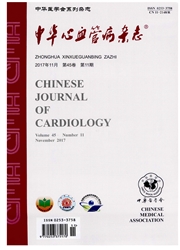

 中文摘要:
中文摘要:
目的 对肥厚型心肌病患者临床特征及其受累肥厚节段的分布和程度进行分析.方法 连续收集2004年3月至2007年3月225例临床诊断或可疑的肥厚型心脏病患者的临床资料,包括症状、体征、心电图检查及超声心动图检查等.所有患者均接受心脏核磁共振检查.依据9节段分析法分析受累节段范围、程度等.结果 肥厚型心肌病患者中男163例,女62例,平均年龄(50.4±14.5)岁.28例肥厚型心肌病患者临床无症状,系通过体检发现.197例肥厚型心肌病患者临床症状明显,其中11例伴发晕厥.216例肥厚型心肌病患者心电图异常,73例患者有明确家族史.126例肥厚型心肌病患者可闻及收缩期杂音.超声心动图发现95例患者合并左心室流出道梗阻,32例患者伴发二尖瓣关闭不全.肥厚型心肌病患者合并高血压50例,合并冠心病14例,合并糖尿病5例.225例患者左心房前后径平均为(39.4±8.3)mm,左心室舒张末期横径平均为(47.8±5.5)mm.依据9节段分析法,32.1%的节段受累.非对称性肥厚患者222例,其中室间隔受累198例,对称性肥厚患者3例.心尖受累67例,其中单独心尖受累24例.98例患者室间隔和左心室前壁同时受累.所有室间隔肥厚患者室间隔平均厚度为(23.0±5.2)mm.其中伴发左心室流出道梗阻患者室间隔平均厚度为(24.3±5.3)mm,高于无梗阻患者(21.6±4.6)mm,P<0.05.所有心尖肥厚患者心尖平均厚度为(15.6±3.4)mm.结论 我国肥厚型心肌病患者男性比例较高,临床发病时间较晚.心脏磁共振能很好地评估肥厚型心肌病各个亚型的病理解剖学特征,是准确诊断肥厚型心肌病的有效方法.
 英文摘要:
英文摘要:
Objective To analyze the clinical data and hypertrophic segments distribution of patients with hypertrophic cardiomyopathy (HCM). Methods Clinical data including signs and symptoms,electrocardiogram and echocardiography were collected. All patients were imaged with cardiac magnetic resonance imaging (CMR). Results From March 2004 to March 2007, 225 consecutive patients [163males, mean age(50. 4 ± 14. 5 )years] with CMR defined HCM were included in this study, positive familial history was obtained in 73 patients, 50 patients were associated with hypertension, 14 patients with coronary artery disease and 5 patients with diabetes mellitus, 28 patients were asymptomatic, 197 patients were symptomatic, and 11 patients with syncope. Electrocardiogram abnormalities occurred in 216 patients.Systolic murmurs were present in 126 patients. Echocardiography examination evidenced left ventricular outflow obstruction in 95 patients, mitral insufficiency in 32 patients, 32. 1% segments were hypertrophied,asymmetrical hypertrophy presented in 222 patients and symmetrical hypertrophy in 3 patients. The left atrial dimension was( 39. 4 ± 8.3 )mm, and left ventricular diastolic dimension was (47. 8 ± 5.5 )mm in this cohort. Apical hypertrophy occurred in 67 patients. The thickness of ventricular septum was (24. 3 ± 5. 3)mm in obstructive HCM and ( 21.6 ± 4. 6) mm in non-obstructive HCM ( P 〈 0. 05 ). The thickness of hypertrophy apical segment was ( 15.6 ± 3.4) mm. Conclusions HCM in Chinese patients is characterized by the high prevalenee among men and late onset of presentation. Combining clinical, electrocardiogram,echocardiographic and CMR results are of importance for correctly diagnosing HCM in daily practice.
 同期刊论文项目
同期刊论文项目
 同项目期刊论文
同项目期刊论文
 期刊信息
期刊信息
